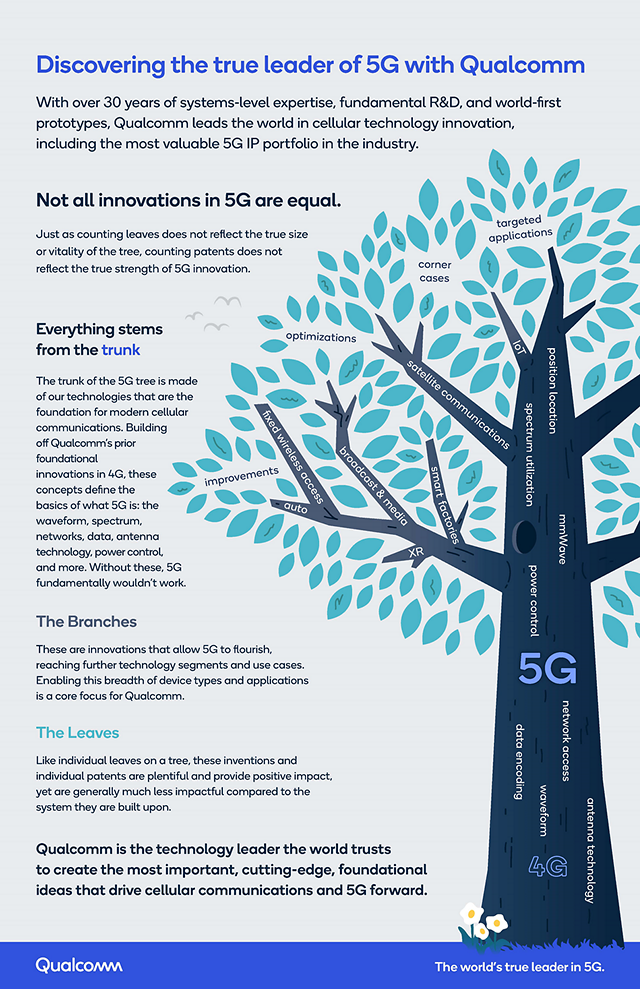Why Qualcomm Is the True Leader in 5G – A Story of Foundational Inventions
Qualcomm invented the underlying technologies that make 5G work.

By Lorenzo Casaccia Vice President of Technical Standards, IP Qualcomm Europe, Inc.
For over 30 years, Qualcomm has led the world in inventing cellular technology and, along the way, has built the most important 5G IP portfolio, as well as the most successful licensing business in the wireless industry.
We create the foundational, cutting-edge ideas that drive cellular communications forward. Our heavy, sustained investment in fundamental R&D, history of standards leadership and creation, leading expertise in nearly every area of cellular, and long history of world-first prototypes and technology demonstrations is unmatched. And we’ve had this focus for decades, with our groundbreaking inventions at the heart of 2G, 3G, 4G, 5G, and now paving the way to 6G.
Given how important 5G has become, there’s been a lot of interest in attempting to determine who leads in 5G invention. Of course, there are many aspects of 5G — from cutting-edge phones, to increased network deployments and new use cases — but at the heart of it all is the technology behind the 5G standard. This technology and how leadership can be measured is incredibly complex when viewed from the outside, so most attempts have taken to simply counting raw numbers of inventions declared to the 5G standard, patents, or contributions to try to guess at who leads in 5G. As we have already explained, simple counting methods like these never show the full picture and provide flawed results.
So let’s set the record straight.
To better understand 5G leadership, it’s helpful to think of 5G as the newest part of a vibrant, decades-old tree.
The trunk of this 5G tree is made up of technologies that are the foundation for 5G mobile broadband. Many of these technologies played a key role in 4G (also known as LTE) and gave us the mobile streaming, high-speed downloads, and massive numbers of connections that we all take for granted today. Qualcomm’s innovators were the pioneering force behind 4G’s foundations, developing:
- The fundamental radio transmission technique (based on orthogonal frequency-division multiplexing, or “OFDM”) that 4G is built upon
- Multiple-access schemes that defined how phones connect to the 4G network
- Carrier aggregation concepts that supercharged 4G data speeds by operating different pieces of spectrum simultaneously
- The use of multiple-input multiple-output antenna technology frameworks called “MIMO” to vastly boost data rates and reliability and several others, including power control and multiplexing concepts, which themselves were rooted in our technologies that defined 3G
In 5G, Qualcomm once again played the role of technology innovation leader, contributing important new ideas and expanding on this 4G base layer. For example:
- Using OFDM with greater flexibility and adaptiveness to network and spectrum conditions
- Adding a scalable numerology framework to be able to use the same system for everything from tiny IoT devices to cars to everything in between
- Using millimeter wave spectrum, never utilized previously for cellular access, for lightning-fast speeds and mobility
- Advanced channel coding to further optimize how very large amounts of data can be sent over the radio waves and decoded efficiently by mobile devices
- Evolving 4G’s MIMO framework to “Massive MIMO” techniques to greatly boost coverage, data rates, and reliability
These Qualcomm inventions at the core of the 5G standard underpin modern cellular communications in everything from the simplest connected parking meters to your smartphone, to the world’s most advanced autonomous factories. This is why we consider them to be the trunk of the 5G tree.
Inventing cellular technologies at this level is incredibly difficult and requires not only deep systems-level understanding and world-leading experience to solve, but also foresight many years in advance, and a very strong pedigree in the design of previous generations of cellular standards.
Looking at 5G innovations using this tree metaphor helps us understand the role and impact of different inventions that make up 5G and how technology leadership is built upon years, or even decades, of sustained innovation.
The branches in the 5G tree are variations of this baseline system that allow 5G to address different segments beyond just phones — things like IoT, connected cars, satellite connectivity, smart factories, broadcast and media, virtual reality, and more. 5G is unique in that it’s the first cellular generation specifically designed to enable all these different applications with a unified design over a common standard. Enabling this breadth of device types, and creating these branches of the standard for new industries, has been another core focus for Qualcomm. Our foundational inventions are at the heart of many of these branches. For example:
- Sidelink communication between cars that will enable better automotive safety features
- High-precision indoor positioning for the factories of the future
- A common standard for satellite and terrestrial communications for coverage across the ~80% of the planet surface not covered by cell towers
- Integration of low-power IOT use cases across a range of devices
- And many more including adaptations of 5G for broadcasting, drones, and shared/unlicensed spectrum
The 5G tree also includes focused inventions that we can think of as leaves on the tree. These are features that improve or optimize a narrow sub-area of the technology — often unique corner cases or highly specific applications. Standing alone, these inventions provide positive impact, yet are generally less impactful to the overall system compared to the core inventions they are built upon. This is one of the key reasons why simply counting numbers of inventions in 5G doesn’t paint an accurate view into technology leadership.
Looking at 5G innovations using this tree metaphor helps us understand the role and impact of different inventions that make up 5G and how technology leadership is built upon years, or even decades, of sustained innovation.
Simply counting the number of inventions or patents someone has in 5G is like counting the leaves on the cellular tree, and comparing them to the trunk or branches. Looking at the 5G IP landscape through this lens, we can clearly see that not all inventions or patents in 5G are equal.
Deep, foundational cellular communications inventions — without which 5G fundamentally doesn’t work — and broad, enabling application technologies are what give 5G its revolutionary capabilities. And often, these technologies have a strong relationship with foundational work that took place in 4G, or in some cases even in 3G. Qualcomm’s vision and expertise have made 5G happen every step of the way and are built on a history of standards creation and leadership that traces back decades. Our inventions make 5G, 5G.
Think of it another way: fifty $1 bills may look like a lot more than a single $100 bill, but the $100 bill is a lot more valuable. Fully appreciating innovation impact and foundationality, beyond counting leaves, enables the real picture to come through. And it is this real picture upon which Qualcomm’s 5G leadership, including the most important 5G IP portfolio and the most successful licensing business in cellular, have been built.
Qualcomm is unique in the mobile technology ecosystem. Our foundational inventions have been at the center of the 3G and 4G standards, and now form the heart of 5G — from the trunk upon which the system is built, to the different branches that enable 5G’s diverse applications — which has resulted in us having the most important 5G IP portfolio in the industry.
Our unparalleled invention leadership is further highlighted by our unmatched technology licensing success, with more than 150 5G licensing agreements signed — by far the most in the industry — and with over 18 billion licensed devices around the world using our inventions.
For over three decades, Qualcomm has been, and continues to be, the indispensable invention leader in cellular.

